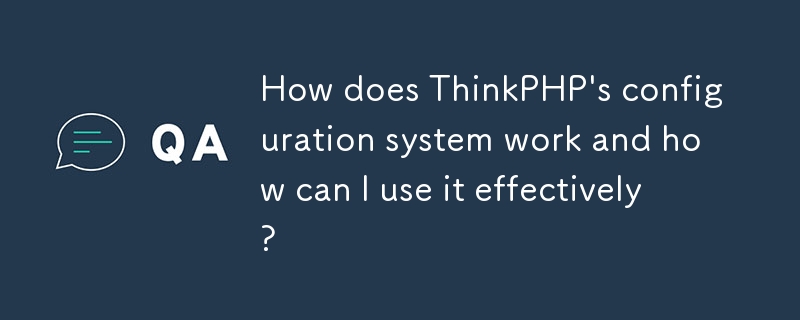 PHP Framework
PHP Framework
 ThinkPHP
ThinkPHP
 How does ThinkPHP's configuration system work and how can I use it effectively?
How does ThinkPHP's configuration system work and how can I use it effectively?
How does ThinkPHP's configuration system work and how can I use it effectively?
This article details ThinkPHP's configuration system, focusing on its functionality, effective usage, and extensibility. It covers configuration file formats (PHP array and XML), environment-specific overrides (using environment variables), and adva

How does ThinkPHP's configuration system work and how can I use it effectively?
ThinkPHP's configuration system is a flexible and powerful mechanism for managing application settings. It primarily relies on configuration files, typically located in the application/config/ directory. These files contain key-value pairs defining various aspects of your application, such as database credentials, routing rules, template settings, and more. ThinkPHP supports multiple configuration file formats (discussed later), but generally uses PHP arrays to define these settings.
The system works by loading configuration files during application initialization. ThinkPHP uses a hierarchical structure, allowing you to define configurations at different levels. For example, you might have a main configuration file (config.php) containing general settings, and then separate files for specific modules or components. When accessing a configuration value, ThinkPHP searches through the configuration hierarchy, prioritizing values defined in more specific files over more general ones.
Effective use involves organizing your configurations logically. Group related settings together, using descriptive keys. Avoid hardcoding configuration values directly in your code. Instead, always access them through ThinkPHP's configuration access methods, such as config('database.host') to retrieve the database host. This promotes maintainability, readability, and makes it easier to manage settings across different environments. Remember to use the appropriate configuration methods for different data types, ensuring type safety and preventing unexpected errors.
What are the different configuration file formats supported by ThinkPHP, and how do I choose the best one for my project?
ThinkPHP primarily supports two configuration file formats:
-
PHP Array Format (.php): This is the most common and recommended format. Configuration data is defined directly as a PHP array within a
.phpfile. This allows for complex data structures and easy access to configuration values. It's highly flexible and readily integrated with ThinkPHP's internal mechanisms. Example:
<?php
return [
'database' => [
'host' => 'localhost',
'username' => 'root',
'password' => 'password',
'database' => 'mydatabase'
],
'app_name' => 'My Application'
];
?>- XML Format (.xml): ThinkPHP also supports XML configuration files. This format is more structured and can be easier to read and edit for some developers. However, it requires more parsing overhead and might be less efficient than the PHP array format. ThinkPHP provides methods to handle XML configuration files seamlessly.
The best choice depends on your project's needs and your team's preferences. For most projects, the PHP array format is recommended due to its simplicity, performance, and seamless integration with ThinkPHP. XML might be considered if you need a more human-readable format or if you have existing XML configuration schemas to integrate.
How can I override ThinkPHP's default configurations in different environments (e.g., development, testing, production)?
ThinkPHP allows for easy configuration overrides across different environments. The most common approach is to use environment-specific configuration files. For example, you might have:
-
config.php(default configuration) -
config_dev.php(development environment) -
config_test.php(testing environment) -
config_prod.php(production environment)
These files can contain overrides for specific configuration values. ThinkPHP's configuration loading mechanism will prioritize environment-specific files over the default config.php. For instance, a database setting defined in config_dev.php will override the same setting in config.php when running in the development environment.
The environment is usually determined by setting the APP_ENV environment variable. You'll need to configure your server (Apache, Nginx, etc.) or your deployment process to set this variable appropriately for each environment. ThinkPHP will automatically load the correct configuration file based on this environment variable.
Can I extend or customize ThinkPHP's configuration system to meet specific project requirements?
Yes, ThinkPHP's configuration system is extensible. You can:
-
Create custom configuration files: Organize your configurations into logically grouped files beyond the default
config.php. ThinkPHP allows loading configurations from multiple files, offering granular control. - Use custom configuration loaders: ThinkPHP allows you to create custom loaders to handle configuration data from non-standard sources (e.g., a database, a remote service, or a different file format). This requires extending ThinkPHP's core configuration mechanisms.
- Create configuration helpers: Develop helper functions or classes to simplify access and manipulation of configuration values. This improves code organization and reduces redundancy.
- Implement caching: For performance optimization, you can cache the loaded configurations to avoid repeated file reads. ThinkPHP offers mechanisms to implement caching, but you might need to customize it based on your chosen caching solution.
Extending the system involves understanding ThinkPHP's internal configuration loading and processing mechanisms. Refer to the official ThinkPHP documentation for detailed instructions and examples on extending core functionality. Remember to thoroughly test any custom configurations and extensions to ensure stability and compatibility with the rest of your application.
The above is the detailed content of How does ThinkPHP's configuration system work and how can I use it effectively?. For more information, please follow other related articles on the PHP Chinese website!

Hot AI Tools

Undresser.AI Undress
AI-powered app for creating realistic nude photos

AI Clothes Remover
Online AI tool for removing clothes from photos.

Undress AI Tool
Undress images for free

Clothoff.io
AI clothes remover

Video Face Swap
Swap faces in any video effortlessly with our completely free AI face swap tool!

Hot Article

Hot Tools

Notepad++7.3.1
Easy-to-use and free code editor

SublimeText3 Chinese version
Chinese version, very easy to use

Zend Studio 13.0.1
Powerful PHP integrated development environment

Dreamweaver CS6
Visual web development tools

SublimeText3 Mac version
God-level code editing software (SublimeText3)




